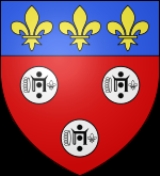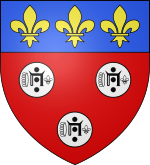
Duke of Chartres
Encyclopedia

Chartres
Chartres is a commune and capital of the Eure-et-Loir department in northern France. It is located southwest of Paris.-Geography:Chartres is built on the left bank of the Eure River, on a hill crowned by its famous cathedral, the spires of which are a landmark in the surrounding country...
, an Earldom. The title of comte de Chartres thus became duc de Chartres. This duchy
Duchy
A duchy is a territory, fief, or domain ruled by a duke or duchess.Some duchies were sovereign in areas that would become unified realms only during the Modern era . In contrast, others were subordinate districts of those kingdoms that unified either partially or completely during the Medieval era...
–peerage
Peerage
The Peerage is a legal system of largely hereditary titles in the United Kingdom, which constitute the ranks of British nobility and is part of the British honours system...
was given by Louis XIV of France
Louis XIV of France
Louis XIV , known as Louis the Great or the Sun King , was a Bourbon monarch who ruled as King of France and Navarre. His reign, from 1643 to his death in 1715, began at the age of four and lasted seventy-two years, three months, and eighteen days...
to his nephew, Philippe II d'Orléans, at his birth in 1674. Philippe II was the younger son and heir of the king's brother, Philippe de France, Duke of Orléans
Philippe I, Duke of Orléans
Philippe of France was the youngest son of Louis XIII of France and his queen consort Anne of Austria. His older brother was the famous Louis XIV, le roi soleil. Styled Duke of Anjou from birth, Philippe became Duke of Orléans upon the death of his uncle Gaston, Duke of Orléans...
.
Carolingian Counts
- 882–886 : Hasting, VikingVikingThe term Viking is customarily used to refer to the Norse explorers, warriors, merchants, and pirates who raided, traded, explored and settled in wide areas of Europe, Asia and the North Atlantic islands from the late 8th to the mid-11th century.These Norsemen used their famed longships to...
chief, defeated by CarlomanCarlomanCarloman is the name of several members of the Frankish ruling family. It is also one translation of the Bulgarian name "Kaliman":* Carloman, father of Pepin I Carloman is the name of several members of the Frankish ruling family. It is also one translation of the Bulgarian name "Kaliman":*...
in 879, agreed to settle in and received the County of Chartres. He sold it in 886 to subsidize an expedition during which he died.
House of Blois
The northern portion of the County of Blois, bordering on NormandyNormandy
Normandy is a geographical region corresponding to the former Duchy of Normandy. It is in France.The continental territory covers 30,627 km² and forms the preponderant part of Normandy and roughly 5% of the territory of France. It is divided for administrative purposes into two régions:...
, was sometimes alienated as the County of Chartres, but the Counts of Blois who possessed it did not use a separate title for it. In 1391, the death of the only son of Guy II, Count of Blois
Guy II, Count of Blois
Guy II of Blois-Châtillon , the youngest son of Louis I of Châtillon and Joan of Avesnes, was count of Blois and lord of Avesnes, Schoonhoven, and Gouda 1381–1397, and lord of Beaumont and Chimay....
prompted him to sell the inheritance of the County of Blois to Louis of Valois, Duke of Orléans
Louis of Valois, Duke of Orléans
Louis I was Duke of Orléans from 1392 to his death. He was also Count of Valois, Duke of Touraine , Count of Blois , Angoulême , Périgord, Dreux, and Soissons....
, merging the title into the royal dukedom.
Duke of Chartres
After its revival and elevation, the title duc de Chartres was used by the House of OrléansHouse of Orleans
Orléans is the name used by several branches of the Royal House of France, all descended in the legitimate male line from the dynasty's founder, Hugh Capet. It became a tradition during France's ancien régime for the duchy of Orléans to be granted as an appanage to a younger son of the king...
, founded by Philippe de France, duc d'Orléans
Philippe I, Duke of Orléans
Philippe of France was the youngest son of Louis XIII of France and his queen consort Anne of Austria. His older brother was the famous Louis XIV, le roi soleil. Styled Duke of Anjou from birth, Philippe became Duke of Orléans upon the death of his uncle Gaston, Duke of Orléans...
, and cadet branch of the House of Bourbon
House of Bourbon
The House of Bourbon is a European royal house, a branch of the Capetian dynasty . Bourbon kings first ruled Navarre and France in the 16th century. By the 18th century, members of the Bourbon dynasty also held thrones in Spain, Naples, Sicily, and Parma...
.
Holders of the title were:
.svg.png)
- Philippe II d'Orléans, duc de ChartresPhilippe II, Duke of OrléansPhilippe d'Orléans was a member of the royal family of France and served as Regent of the Kingdom from 1715 to 1723. Born at his father's palace at Saint-Cloud, he was known from birth under the title of Duke of Chartres...
(1674–1723),- Regent of France from 1715 to 1723;
- Louis d'Orléans, duc de ChartresLouis of Bourbon, Duke of OrléansLouis d'Orléans was the Duke of Orléans and a member of the royal family of France, the House of Bourbon, and as such was a prince du sang. At his father's death, he became the First Prince of the Blood...
(1703–1752); - Louis Philippe I d'Orléans, duc de ChartresLouis Philippe I, Duke of OrléansLouis Philippe d'Orléans known as le Gros , was a French nobleman, a member of a cadet branch of the House of Bourbon, the dynasty then ruling France. The First Prince of the Blood after 1752, he was the most senior male at the French court after the immediate royal family. He was the father of...
(1725–1785); - Louis Philippe II d'Orléans, duc de Chartres (1747–1793),
- Philippe Égalité during the French Revolution of 1789;
- Louis-Philippe III d'Orléans, duc de ChartresLouis-Philippe of FranceLouis Philippe I was King of the French from 1830 to 1848 in what was known as the July Monarchy. His father was a duke who supported the French Revolution but was nevertheless guillotined. Louis Philippe fled France as a young man and spent 21 years in exile, including considerable time in the...
(1773–1850),- Louis-Philippe I, King of the French from 1830 to 1848.
- Ferdinand Philippe d'Orléans, duc de Chartres (1810–1842),
- eldest son of King Louis-Philippe.
After 1848
- Robert, a younger brother of the comte de Paris was titled duc de Chartres (1840–1910).
The title is currently held, as a courtesy title, by
- Charles-Louis, duc de ChartresCharles-Louis, duc de ChartresCharles-Louis Henri Foulques Benoît Elzéar Jean Marie d'Orléans, Petit-Fils de France, duc de Chartres was born on 28 July 1972. He is the son of Jacques Jean Yaroslaw Marie d'Orléans, Prince de France and Gersende de Sabran-Pontèves. His paternal grandfather was the late Henri, Count of Paris who...
,- son of the Orléanist claimant to the throne of France, Jacques, duc d'OrléansJacques, duc d'OrléansPrince Jacques Jean Jaroslaw Marie d'Orléans, Fils de France, Duke of Orleans, was born on 25 June 1941 in Rabat, Morocco. He is the son of the late Henri Robert Ferdinand Marie Louis Philippe d'Orléans and Isabelle Marie de Orléans Bragança.-Family:He married Gersende Thérèse Françoise de...
.
- son of the Orléanist claimant to the throne of France, Jacques, duc d'Orléans

